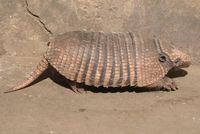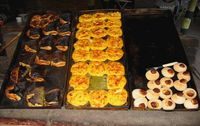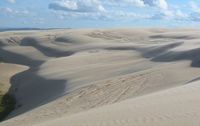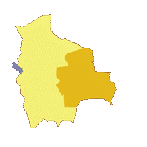Tropical mushroom city
 Santa Cruz
Santa Cruz ![]() is located in the Eastern plains of Bolivia
(llanos), in the middle of vast tropical meadows and forests. The hot and wet climate is favorable to the
development of intensive and diverse agriculture (cotton, sugar cane, tobacco, rice, soya, fruits...) and
also to the breeding of cattle.
is located in the Eastern plains of Bolivia
(llanos), in the middle of vast tropical meadows and forests. The hot and wet climate is favorable to the
development of intensive and diverse agriculture (cotton, sugar cane, tobacco, rice, soya, fruits...) and
also to the breeding of cattle.
The temperatures are on average 30 degrees in spring and summer, and 20 degrees in winter. It is not unusual to have polar cold weather fronts (surazos) coming from the south during the winter.
Santa Cruz is a modern city and is perpetually under development. Agricultural products as well as the exploitation of oil reserves, natural gas and ores (iron, manganese and gold) ensured a fast and durable growth which brought the city to the forefront of the bolivian economy during the past decades. Profiting from an advantageous geographical position, the city has established important trade at the national level with the principal cities of the country and, at the international level, with Brazil.
The city is organized into 9 concentric rings. The first ring including the colonial district and principal tourist centers (hotel, restaurants, shopping centres, museums) is called casco viejo. The second and subsequent rings comprise residential and industrial areas.
The awakening of the Cambas
he inhabitants of the area of Oriente (Santa Cruz, Beni and Pando) are called Cambas. The origin of the word Camba comes from "cumbae"="honorable friend" in the Guarani language. It was initially used at the time of Spanish colonization to designate the natives who populated the area of Santa Cruz. During the centuries which followed the colonization, the Camba peasants were relegated to the second place behind the Andean people (the Collas) who held the political and economical power of the country. Since the middle of the XXth century, the Camba population re-awakened with the development of trade, flourishing agriculture, and the exploitation of the oil reserves.
The history of the Cambas features much international ethnic mixing. They count a large proportion of white and mongrel people compared to their neighbors Collas for whom the Indian quechuas and aymaras origins are dominant.
The socio-economic models developed by the Cambas and Collas are rather different and today generate many tensions between the two populations. The nationalist feeling unfortunately starts to divide Bolivia, with Cambas claiming independence for their rich province, and the Collas proudly defending the Indian values.
Historical milestones
- Built as a defense wall against the expansion of Portuguese, Santa Cruz was founded in 1561 by the Spanish captain Ñuflo de Chávez on the Guapay river banks, not far from current San José de Chiquitos. Considered to be too vulnerable to the attacks of the local Indian tribes, the city was moved several times in the years which followed, to its current location on the Piray river banks (more than 200 km to the west of its original location).
 At the time of Spanish colonization (XVIth and XVIIth centuries), the
city was used as a strategic center and starting point for evangelization expeditions. The Jesuit missions particularly
those near Moxos and Chiquitos, sought to bring christianity to the Indians of the region.
At the time of Spanish colonization (XVIth and XVIIth centuries), the
city was used as a strategic center and starting point for evangelization expeditions. The Jesuit missions particularly
those near Moxos and Chiquitos, sought to bring christianity to the Indians of the region.- Santa Cruz then made an important step forwards being used as the supply center of agricultural products for the principal cities of the altiplano. Its development was brutally stopped at the beginning of XIXth century when new, more competitive, commercial connections were established between La Paz and Peru.
- In the middle of the 1950s, the activity of the city was stimulated by the construction of fast transportation routes (motorway, railroad) between La Paz and Brazil.
Santa Cruz sightseeing
- Catedral Metropolitana San Lorenzo on the central Plaza 24 de Septiembre. Founded in 1605, the current structure was built between 1845 and 1915. Admire the carved wooden vaults and the silver decorations of the furnace bridge inherited from the Jesuit mission of San Pedro de Moxos.
- Museo catedrádico de Arte Sacro: this small museum, which is next to the cathedral, has a collection of religious objects belonging to the Jesuit missions (jewels, silverware, ceremonial clothing, paintings).
-
Museo de historia natural
 has a collection of tropical animals, particularly a great variety of fish and insects.
has a collection of tropical animals, particularly a great variety of fish and insects. - Parque El Arenal: located a few blocks away from the central square, this park offers a great open space where the inhabitants of Santa Cruz come to relax near the lagoon. The cultural attraction of the park is the museo Etno-Folklárorico which presents a handfull of artistic objects from various Camba ethnic groups.
 The
Zoo
The
Zoo  : a pretty park full of greenery. A pleasant place to walk in the fresh
air and to admire the few sloths perched in the trees. Lack of finance unfortunatly means it is not possible to offer to the
animals (all from South America) a little more space and freedom.
: a pretty park full of greenery. A pleasant place to walk in the fresh
air and to admire the few sloths perched in the trees. Lack of finance unfortunatly means it is not possible to offer to the
animals (all from South America) a little more space and freedom. Las
cabañas del Piray
Las
cabañas del Piray  : located in the western part of the city, at the end
of Roca Coronado avenue, this small restaurant-village is situated in a forest park at the edge of the Piray river. In the
many huts, one can taste typical Camba dishes like panes de arroz, tamales, cuñapes, empanadas fritas de queso
: located in the western part of the city, at the end
of Roca Coronado avenue, this small restaurant-village is situated in a forest park at the edge of the Piray river. In the
many huts, one can taste typical Camba dishes like panes de arroz, tamales, cuñapes, empanadas fritas de queso
Excursions around Santa Cruz
 Las
lomas de arena del Palmar
Las
lomas de arena del Palmar  : incredible landscape made up of enormous
sand dunes - the natural result of strong wind erosion of sedimentary rocks - 16 km to the south of Santa Cruz. One can go there
by taxi (more economic than renting a 4 wheel drive) but do not be surprised if your car sinks into the sandy road (nothing
really serious, it may be necessary to push the car a little to get going again!).
: incredible landscape made up of enormous
sand dunes - the natural result of strong wind erosion of sedimentary rocks - 16 km to the south of Santa Cruz. One can go there
by taxi (more economic than renting a 4 wheel drive) but do not be surprised if your car sinks into the sandy road (nothing
really serious, it may be necessary to push the car a little to get going again!).- The tour of Jesuit missions: in the area of Chiquitanía in the North-East of Santa Cruz, one can admire the heritage left by the Jesuit missionaries in the principal cities: San Javier, San Rafael de Velasco, Concepción, San Miguel de Velasco, San Ignacio de Velasco, Santa Ana de Velasco.
 Samaipata
Samaipata  : 118km from Santa Cruz is the small and peaceful village of Samaipata,
surrounded by the hills and valleys of Amboro national park at an altitude of 1660m (on the butress of the Eastern Cordillera).
The tourist attraction of the site is a fortress built before the Inca time and declared as cultural world heritage by UNESCO.
: 118km from Santa Cruz is the small and peaceful village of Samaipata,
surrounded by the hills and valleys of Amboro national park at an altitude of 1660m (on the butress of the Eastern Cordillera).
The tourist attraction of the site is a fortress built before the Inca time and declared as cultural world heritage by UNESCO.- La
cueva de los monos (the monkeys' cave)
 : In Bermejo, 85 Km from Santa Cruz on the road to Samaipata, one can admire the enormous red rock.
: In Bermejo, 85 Km from Santa Cruz on the road to Samaipata, one can admire the enormous red rock.







